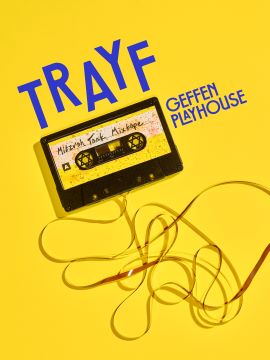SCHISM BUDDIES
“Are you Jewish?” Spoken by the leading players in playwright Lindsay Joelle’s Trayf, the question could also be relevant for the audience itself. Before you walk away dejected, know this: if you’ve never greeted anyone with “shalom” or heard of a “Mitzvah tank,” you’re probably (surprisingly) the play’s target audience – or at least, alongside a spectrum of Jewish neighbors, a welcome guest at its table. Now getting its West Coast Premiere at the Geffen Playhouse’s more intimate Audrey Skirball Kenis Theater, Trayf follows the lives of Zalmy and Shmuel, two Hasidic Jews and childhood friends on the brink of coming apart in this touching, coming-of-age “buddy comedy” directed to mixed results by Maggie Burrows.
Ilan Eskenazi and Ben Hirschhorn
The play, set in early 90s New York, is deeply, perhaps “otherly” Jewish. It delves into the particulars of the Chabad-Lubavitch dynasty of Hasidic Orthodox Judaism. In Trayf (a Yiddish word meaning “not satisfying the requirements of Jewish law” or “not kosher”), Joelle pushes the boundaries of her target audience. Instead of watering down the language and specifics of this particular subculture to appeal to a broader audience, she opts instead to immerse attendees fully within it – in a breezy 80 minutes. Not every Jewish word, name, or ritual in the play gets fully explained, yet enough context is given for diverse audiences to follow along. It’s this “outsider” perspective that makes the work both daring and universal. If theatergoers can find ways to connect with characters vastly different from themselves, all the better for our collective humanity.
Ilan Eskenazi and Garrett Young
Eighteen-year-olds Zalmy (Ilan Eskenazi) and Shmuel (Ben Hirschhorn) spend their days eating Twizzlers and listening to taped recordings of their spiritual leader, Rebbe Schneerson, a man they believe to be the Moshiach, or Jewish Messiah. From their synagogue-on-wheels known as a Mitzvah tank, they trade Rebbe-quotes to pass the time and offer Jewish law-affirming “mitzvahs on the spot” to non-observant Jewish Brooklynites “on the go.” It’s here they meet Jonathan (Garrett Young), a distraught, worldly man desperate for their teachings, even if he’s not technically Jewish.
Ilan Eskenazi and Garrett Young
It’s through Jonathan that playwright Joelle is able to explain Hasidic culture to the audience, and offer Zalmy – a sheltered seeker and outsider in his own right – a peek into Jonathan’s forbidden, secular world. In a standout scene, Zalmy (while outside earshot of his best friend Shmuel) questions Jonathan about music and girls. Eagerly bursting with secret longings, he tries, and fails, to prevent Jonathan from seeing him as anything other than naïve. Eskenazi’s portrayal of the Orthodox teen is adorable and heartbreaking. Before long, however, Zalmy and Jonathan are able to find in each other what they’re uniquely, desperately craving.
Ilan Eskenazi and Ben Hirschhorn
Meanwhile Shmuel, played with a contained directness by Hirschhorn, is unaware how far off Zalmy is heading from what he assumes is their mutual spiritual path. Yet the devout one isn’t naïve enough not to see that something’s amiss, as his jealousy of Zalmy and Jonathan’s blossoming friendship overwhelms him. Thrown into the mix is Jonathan’s girlfriend, Leah (Louisa Jacobson). While her appearance far into the play is refreshing – and Jacobson’s performance is poignant – the role is regrettably underutilized.
Ben Hirschhorn and Ilan Eskenazi
As is the theater space itself. Tim Mackabee’s set design does get its moment to shine with the help of lighting designer Lap Chi Chu, but for the most part – minus a street lamp, cassette player, and paper sign taped to the theater’s dark back wall – the set is barren. While we keep hearing references to the boys’ “Mitzvah tank,” it’s never quite clear what, or where, that is. (Are we in or outside – or both – some sort of vehicle? If so, what kind? Or are we in a bedroom? Or a synagogue office? Perhaps we’re streetside? Or in a park?) Because the script has already thrown us into the deep end with religious traditions and jargon, what’s lacking is a set that grounds a mixed audience to clear, specific locations.
Ben Hirschhorn and Louisa Jacobson
Also unfortunate is how director Burrows blocks the actors on the 3/4 thrust stage. While certain scenes play beautifully to those at the top of the horseshoe-shaped seating arrangement, they play poorly for those along the sides. There, theatergoers are prevented from seeing certain actors’ faces for extended periods of time. More positively, costume designer Denitsa Bliznakova creates authentic looks for each of the characters. And Everett Elton Bradman’s sound design, featured prominently during scene changes, is a perfect mixtape of period Top 40 hits and traditional Jewish songs.
Garrett Young and Ilan Eskenazi
Even with the play and production’s weaknesses, Trayf ultimately succeeds in its tender bittersweetness, a hallmark of many coming-of-age tales. While this buddy “bromance” is told from the unique vantage point of Jewish orthodoxy, its universal themes are prominent: feeling sheltered and constricted, or controlling and jealous, perhaps in need of structure or family. Anyone who’s ever been a seeker, or looked for a grass “always greener,” can likely relate to Joelle’s tale. Minus a loose end or two, the story comes together nicely. If only we all could. Trayf touchingly reminds us that, depending on where we’re standing, everyone’s an outsider in need of a seat at the table.
photos by Jeff Lorch
Trayf
Geffen Playhouse, 10866 Le Conte Avenue in Westwood
Tues-Fri at 8; Sat at 3 & 8; Sun at 2 & 7
ends on April 10, 2022
for tickets ($30.00 – $129.00), call 310.208.2028 or visit Geffen Playhouse

